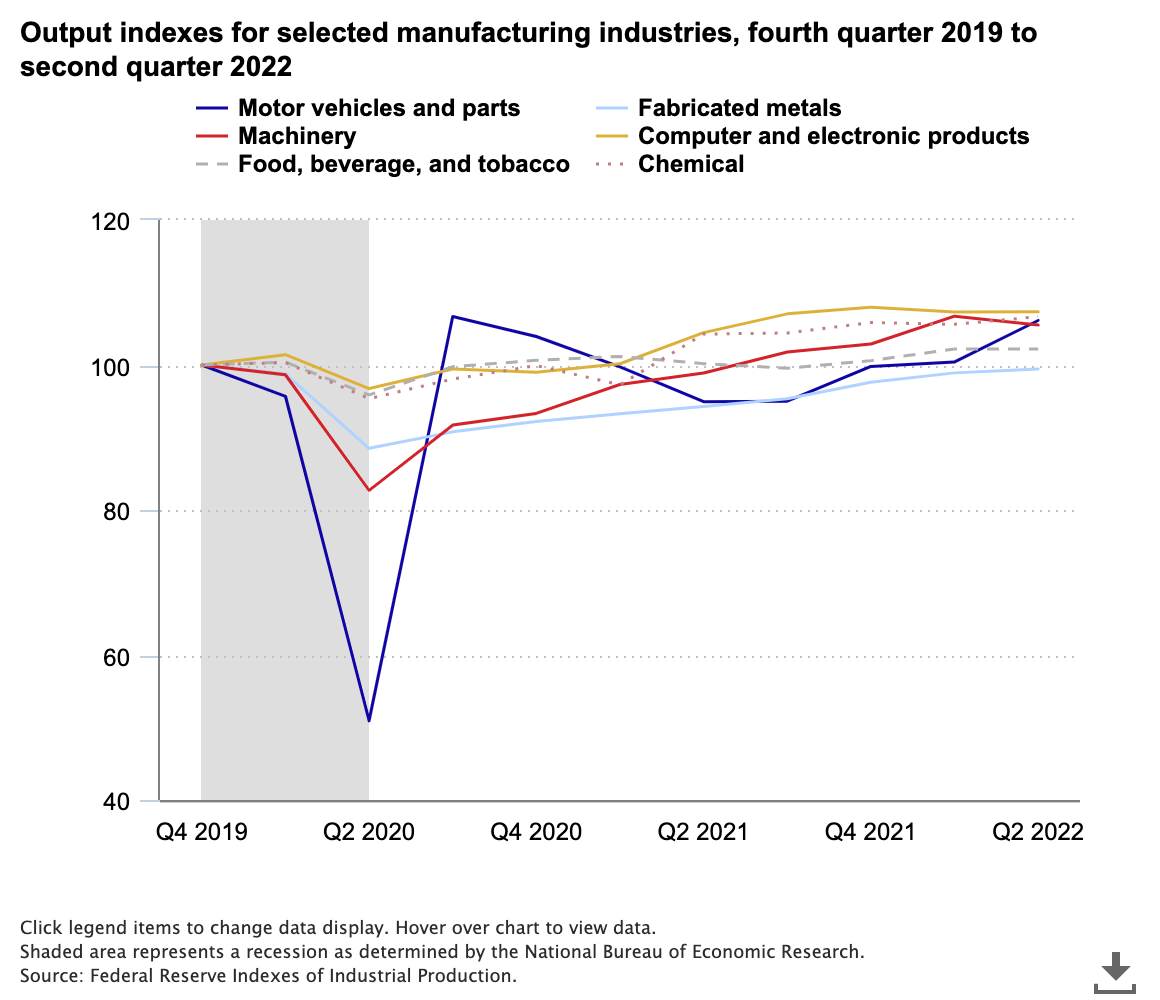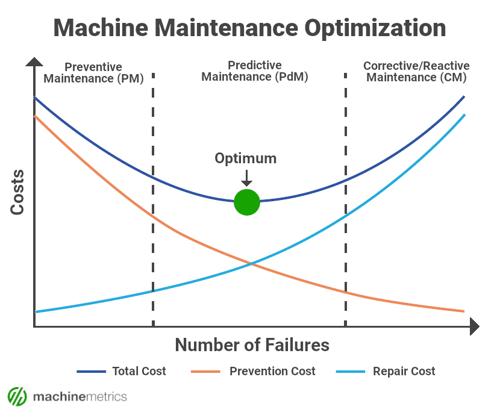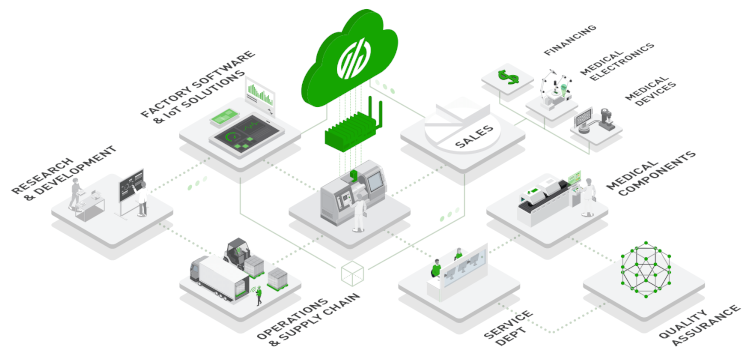Key Takeaways:
- Reducing production costs involves optimizing processes, minimizing waste, and leveraging automation.
- Identifying and eliminating inefficiencies can lead to significant cost savings and improved profitability.
- Continuous process improvement and adopting new technologies are key strategies for maintaining competitive production costs.
Supply chain disruptions, shortages, rising energy prices, and inflation have increased costs for almost every industry, manufacturing included. On top of that, skilled labor is difficult to find, and rising quickly in cost as a result.
The good news is that production (output) in the US continues to rise over time, and we are seeing a resurgence since the dip during the Pandemic.
 (Image Source: U.S. Bureau of Labor Statistics
(Image Source: U.S. Bureau of Labor Statistics
We are heading in the right direction as an industry, but reducing production costs remains a major challenge.
Below we examine the costs involved in manufacturing and strategic ways to reduce them.
What Are Production Costs?
Production costs represent the “all in” number to produce finished goods, consisting of direct and indirect costs associated with production.
Understanding production costs allows companies to manage cash flow, set production targets, and determine sales and pricing strategies. It also helps manufacturers identify areas in which they can increase efficiency and reduce costs.
Key production costs include:
Direct Costs
Direct costs encompass the money directly spent to make a finished good from start to finish. They include direct labor costs, direct material costs, consumables, and general overhead costs for the facility (energy costs, water, etc.).
Indirect Costs
Indirect costs are incurred during the production of finished units but cannot be tied directly to production on a per-unit basis. They’re considered overhead costs and are usually lumped together and then allocated based on the units produced. Indirect costs include:
- Administrative costs such as clerical or data entry labor
- Supply costs for things like office supplies
- Inventory carrying cost for buffer stock and supplies
- Fixed and variable costs for items like trash removal and cleaning
- Annual salaries
- Maintenance costs
How Do You Calculate the Cost of Production?
Calculating production costs requires capturing all direct and indirect costs. Production costs don’t include profit or margin calculations.
The formula is straightforward:
(Direct Cost + Indirect Cost) / Units Produced = Production Costs
Why is it Important to Reduce Production Costs?
As you can imagine, the primary reason to reduce production costs is to increase the profit generated by selling finished goods. Many industries operate on thin margins because they produce at a high volume.
In contrast, others operate on higher margins because the finished goods are produced in batches or as part of high-mix-low-volume operations.
A company’s financial health deteriorates if production costs suffocate profits. The company may be forced to eliminate lower-profit goods and concentrate on higher-margin production to stay afloat.
Production Costs vs. Manufacturing Costs
Production and manufacturing costs are different. Production costs reflect all of the types of costs listed above, while total manufacturing costs consist only of those used to produce the goods physically. These costs include labor, raw materials, and consumables.
7 Ways to Reduce Production Costs
There are various steps you can take to reduce costs in your organization. Many of them are achieved using data from your operations. Production monitoring solutions can capture shop floor data in real-time to prioritize cost-reduction strategies.
1. Audit Your Operation
Every company should conduct a self-audit, which includes a deep dive into every manufacturing process. This means auditing labor utilization to determine if staff are being used efficiently and training is sufficient.
It also means reviewing floor inventory procedures like WIP staging and looking at raw materials for substitutions that would improve its manufacturability or use less material.
The audit should also include indirect, administrative, and other overhead costs. It should look at fixed and variable costs for any area that isn’t directly related to producing a finished good.

2. Implement Continuous Improvement Programs
Many costs can be reduced by implementing lean manufacturing principles. But regardless of the methodology, every company should deploy continuous improvement initiatives to optimize processes. If you're wondering how to reduce cost in manufacturing, continuous improvement is one of the most effective starting points.
But how can you get started with continuous improvement programs?
Continuous improvement initiatives can include simple steps such as eliminating redundant paperwork, automating data entry, and changing equipment and material staging. It can also include more complex changes such as re-evaluating procedures, improving training, and moving from a quality control to a quality management strategy.
Many manufacturers assume that their current processes — that have worked for them for so long already — are fine as they are. However, process issues are quickly uncovered when the focus shifts to reducing costs and identifying a better way to complete tasks.
3. Improve Visibility
Many manufacturing companies operate in the blind. Material goes in one end of the factory, and finished goods come out the other; what happens in between is often mysterious and costly.
The best way to gain visibility is by using machine monitoring solutions. This opportunity is enhanced further when the software captures and analyzes data in real-time. This real-time visibility provides team members with immediately actionable information, so they can intervene when needed. It also gives managers the tools to see what is happening when it matters most.
See MachineMetrics in action to start unlocking production visibility.
4. Optimize Inventory Procedures
There are numerous ways to optimize inventory procedures to reduce costs, but all require at least some degree of technology to succeed. Given the current global disruption, companies need more safety stock to fill orders confidently. This change from strategies such as JIT means calculating the right safety stock and using real-time data to optimize reorder points.
Inventory management software can help balance inventory and ensure materials are placed in the right machine at the right time. This software can also enable proper auditing procedures and, in many cases, facilitate automatic transactions for a perpetual inventory system.
5. Streamline Supply Chains and Procurement
Supply chains often suffer the same visibility dilemma that production floors do. Supply chain software can be deployed to help automate minimum order replenishment and monitor inbound materials.
If supply chain software is integrated into a production monitoring system, it can produce a seamless data flow that lowers costs through reduced idle time, optimized production lot sizes, and more.
The software also creates end-to-end visibility that tracks material from the order point at the vendor to delivery to the customer. Lower costs within the supply chain create the conditions for more efficient production and lower lead times.
6. Implement Predictive Maintenance
Most manufacturers are well past traditional reactive maintenance strategies and are utilizing some form of preventive maintenance. But technology and advanced machine data platforms allow new and more advanced strategies like predictive maintenance.
When machine assets are connected in a machine data platform and production monitoring is automated, advanced analytics can identify trends that optimize service and repair. For example, service may be conducted during changeovers to minimize downtime.
Parts can also be automatically staged, and technicians can be alerted to perform the repair and put the machine back in service faster. All of these practices reduce maintenance costs.

7. Eliminate Waste
Waste is a common enemy in manufacturing operations. By identifying waste, manufacturers can lower production costs and boost efficiency. One key area to look at is material waste from scrap caused by inefficient processes or human error.
But the war on waste isn’t just a material issue; waste can also take the form of labor in situations such as waiting or unnecessary WIP build-up. It can also be a function of non-value-added steps like manual inspection.
Reducing cost of production with MachineMetrics
MachineMetrics offers a best-in-breed solution to capture shop floor data directly from equipment (no operator input necessary!).
This provides frontline workers with the visibility into production that's necessary to take action. It also helps to support the analysis of processes to identify where waste exists, where bottlenecks may be, why downtime occurred, and where additional capacity can be exploited.
With out-of-the-box reports and dashboards, users can be up and running quickly with the information they need to identify waste across all their processes.
Contact us to learn more about how our platform can help you lower costs. Or, watch the platform in action for yourself:
Want to See the Platform in Action?


.png?width=1960&height=1300&name=01_comp_Downtime-%26-Quality_laptop%20(1).png)






Comments